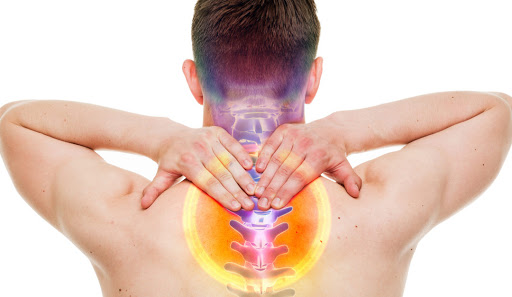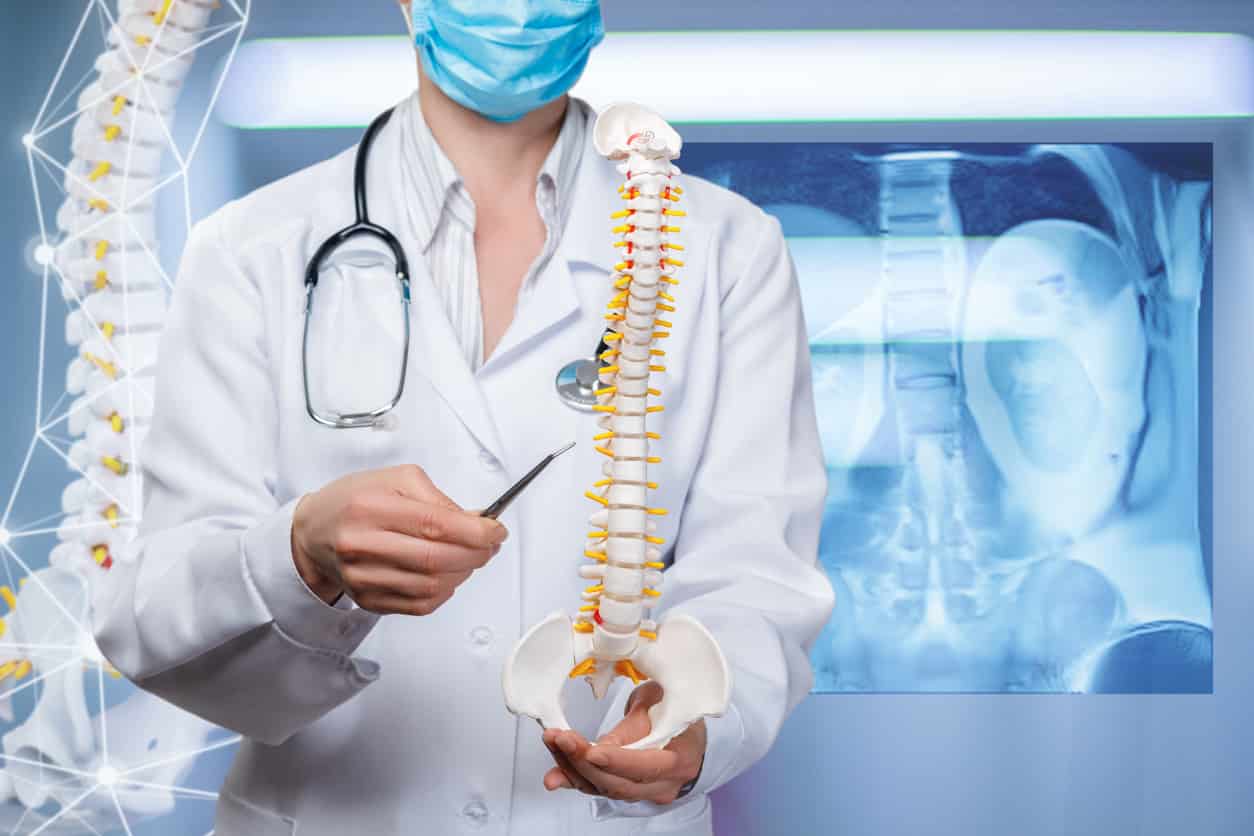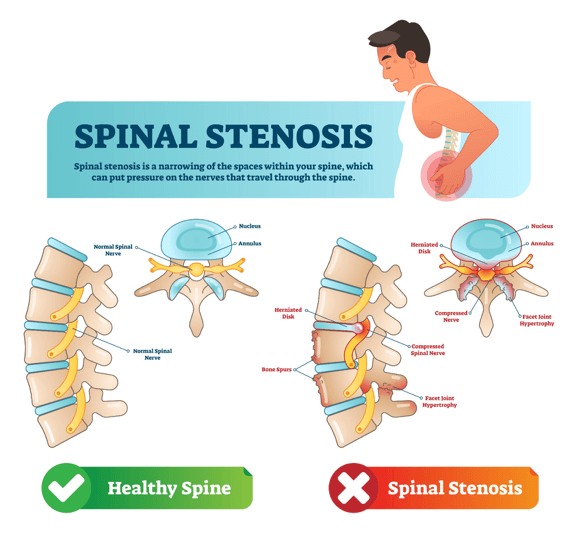WE’VE GOT YOUR BACK: SPINE CONDITIONS
The spine is our body’s main support system. It’s composed of 33 bones and allows us to stand, bend and twist. Our actual spinal cord is protected from harmful injuries by the bony structure. Although our spine remains of utmost importance in regards to our anatomy, it’s also very easily injured.
In order to have a healthy spine, our back’s muscles, bones, flexible tendons and ligaments, and sensitive nerves all contribute. If any of these are struck by a strain, injury or disease there can be some serious repercussions. Spine and back pain management is something we take very seriously at Specialty Care Clinics.
We offer expert assessments and treatments for a full range of spinal problems to help you understand and improve your symptoms. In this article, I’ll be discussing common spinal disorders along with conditions treated specifically at SCC.

SCOLIOSIS & KYPHOSIS
When a spine has an “S” or “C” curvature, this is called scoliosis. It’s most common among kids and teens. About 3% of all children have the disease. Most cases are mild and doctors aren’t sure what the root cause is. But, some conditions like cerebral palsy and muscular dystrophy can cause scoliosis and may increase the severity over time.
There are four types of scoliosis: idiopathic, congenital, neuromuscular and degenerative. Idiopathic means the cause of the scoliosis is unknown and accounts for about 8 out of every 10 cases. Degenerative scoliosis tends to occur later in life whenever our bodies begin to degenerate.
Neuromuscular more than likely will occur in individuals who already can’t walk due to a condition they currently have. Finally, congenital scoliosis develops while growing in utero and shows itself in infancy. The congenital type of scoliosis proves to be very rare and usually ends in spinal surgery.
Kyphosis is a relatively common condition that can occur at any age but is most common among older women. It’s defined as abnormal or excessive rounding of the upper back giving you a “humpback” shape.
Now, don’t panic if your upper back shows signs of rounding, having a small curve in the upper back is very normal. Kyphosis can be caused by spinal abnormalities, age-related health conditions and even poor posture!
The spinal curve’s not always noticeable. If your case is mild, it may look like you’re bending forward a tad, but those around you will most likely not notice unless you point it out. Some symptoms of the condition include back pain and stiffness, a rounded back, and tight hamstrings.
Treatments for kyphosis vary depending on the severity of the curve. Nonsurgical treatment includes physical therapy or a spinal brace to correct posture. Patients with severe forms of the conditions may benefit from having a surgical procedure done. A common surgery used to correct kyphosis is a spinal fusion.
OSTEOPOROSIS
Have you ever heard of holey bones? Well, these “holey bones” are actually a sign of the bone disease called osteoporosis. Osteoporosis occurs when the body loses too much of its bone density.
The loss of bone mass causes the bones to become weak, thus leading to an increase in likelihood of broken bones. Under a microscope, bones suffering from osteoporosis look like a honeycomb or tiny swiss cheese holes.
This particular bone disease is pretty common, affecting around 54 million Americans. Osteoporosis is quite serious especially as we increase in age. The most common broken bones in relation to osteoporosis are the hip, wrist and spine.
The reason osteopractic bone breaks are so serious is because of permanent pain it causes. Also, the disease can cause some people to physically lose their height due to its relation to kyphosis, or hunchback. Along with permanent pain and height loss, osteoporosis may also limit the patient’s mobility which can lead to a decline in mental health.
About 20% of senior citizens who suffer from a broken hip pass away within a year due to either complications from the injury or the surgery it takes to repair it.

DEGENERATIVE DISC DISEASE
One of the most common causes of lower back and neck pain is degenerative disc disease (DDD). The disease is a form of arthritis in the spine where the cartilage and joints begin to wear out which may begin to cause pain in the neck.
In some cases, there are no symptoms at all, in other cases patients begin to lose spinal flexibility and pinched nerves are common. DDD is less of a disease and more of a natural occurrence that develops with age.
As people age, daily stress on the spine can damage it. The damage caused by the stress or injury tends to affect the spinal discs and causes some changes. These changes include loss of fluid and tears/cracks in disc structure.
We’ve Got Your Back: Spine Conditions
To compensate for the declining spinal padding, the body creates small projections called bone spurs on the edges of bones. Bone spurs can sometimes press against either the spinal cord or the spinal nerve root which can cause severe pain and compromise nerve function.
DDD is treated by occupational or physical therapy, exercise and weight loss, medications, and sometimes surgery. Anesthetic or steroid injections into the joints next to damaged discs provide effective pain relief as well. These types of injections are called facet joints. Common medications used to treat pain caused by DDD include Tylnol and ibuprofen with the occasional steroid and muscle relaxer.

SPINAL STENOSIS
Yet another age-related condition is narrowing of the spinal canal: spinal stenosis. This causes spinal nerve compression which almost always leads to pain and dysfunction. As previously mentioned, spinal stenosis comes with age. It’s most common among people over the age of 50.
Also, it’s the most common reason for back surgery in people over 65. However, being young doesn’t protect you against the disease. Young people who’ve had a serious spinal injury can develop spinal stenosis.
There are two types of spinal stenosis: lumbar and cervical. Lumbar spinal stenosis refers to spinal narrowing in the lower back. Back pain as well as numbness, weakness or tingling in your foot or leg is often associated with this. Cervical spinal stenosis is spinal narrowing in the neck region.
Symptoms of cervical spinal stenosis are very similar to lumbar spinal stenosis. Numbness, tingling or weakness in a hand or arm are a result of cervical spinal stenosis. Symptoms of either type don’t always reveal themselves, but evidence of spinal stenosis can be shown in an MRI or CT scan.
Other than old age, what exactly causes spinal stenosis? Well, a few causes that can lead to spinal stenosis are the overgrowth of bone, herniated disks, thickened ligaments, tumors and spinal injuries. Unfortunately, there’s currently no cure for the condition. Without treatment, spinal stenosis progressively gets worse overtime.
Specialty Care Clinics offers spine and back pain management for all conditions listed and described above. Our providers are prepared to relieve, resolve and retrain your back to further improve your life.
If you or anyone you know is suffering from a spinal disease, disorder or chronic pain, the expert providers at SCC want to take care of your health and help you recover.
Call us today at (469) 545-9983 to book an appointment.
